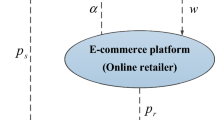Abstract
As advances in information technologies (IT) significantly reduce the time and cost of acquiring and processing product information, some buyers that traditionally work with one or few suppliers have switched to the market environment. The rapid growth of e-commerce has led researchers to believe that a uniform shift to the electronic markets is inevitable. This article examines the issue from the perspective of uncertain supplier’s performance, switching costs, and the value of information. We show that the presence of uncertainty and switching costs favors contractual relationships between buyers and suppliers. As IT makes the market more competitive, the marginal value of information diminishes. Meanwhile, the overall effect of IT on uncertainty and switching costs is fairly limited. As a result, buyers facing high uncertain supplier’s performance and switching costs may find working with a small number of suppliers a better choice.
Similar content being viewed by others
References
Akerlof, G.A. (1970). “The Market for Lemons: Quality Uncertainty and the Market Mechanism.” Quality Journal of Economics 485–500.
Bakos, J.Y. and E. Brynjolfsson. (1993). “Information Technology, Incentives, and the Optimal Number of Suppliers.” Journal of Management Information Systems 10(2), 37–53.
Beggs, A. (1989). “A Note on Switching Costs and Technology Choice.” The Journal of Industrial Economics 17(4), 437–440.
Beggs, A. and P. Klemperer. (1992). “Multi-Period Competition with Switching Costs.” Econometrica 60(3), 651–666.
Bensaou, M. and N. Venkatraman. (1996). “Inter-organizational Relationships and Information Technology.” Eur. J. of Info. Sys. 5(2), 84–91.
Clemens, E.K., S.P. Raddi, and M. Row. (1993). “The Impact of Information Technology on the Organization of Economic Activity: The ‘Move to the Middle’ Hypothesis.” Journal of Management Information Systems 10(2).
Farrell, J. and C. Shapiro. (1988). “Dynamic Competition with Switching Costs.” Rand Journal of Economics 19, 123–137.
Farrell, J. and C. Shapiro. (1989). “Optimal Contracts with Lock-in.” The American Economic Review 79(1), 51–68.
Klemperer, P. (1987). “The Competitiveness of Markets with Switching Costs.” Rand Journal of Economics 18(1), 138–150.
Klemperer, P. (1988). “Welfare Effects of Entry into Markets with Switching Costs.” Journal of Industrial Economics 37, 159–165.
Landeros, R. and R. Monczka. (1989). “Cooperative Buyer/Seller Relationships and a Firm’s Competitive Posture.” Journal of Purchasing and Materials Management Fall, 9–18.
Lascells, D.M. and E.G. Dale. (1989). “The Buyer/Seller Relationship in Total Quality Management.” Journal of Purchasing and Materials Management 10–19.
McFarlan, F.W. (1984). “Information Technology Changes the Way You Compete.” Harvard Business Review 62(3), 98–103.
Malone, T.W. (1986). “A Formal Model of Organizational Structure and its Use in Predicting Effects of Information Technology.” Sloan School of Management Working Paper, No.1849-86, MIT, Cambridge, Mass.
Malone, T.W. (1987). “Modeling Coordination in Organizations and Markets.” Management Science 13(10), 1317–1332.
Malone, T.W., J. Yates, and R.I. Benjamin. (1987). “Electronic Markets and Electronic Hierarchies.” Commun. ACM 30(6), 484–497.
Malone, T.W., J. Yates, and R.I. Benjamin. (1989). “The Logic of Electronic Markets.” Harvard Business Review 166–170.
Rohatgi, V.K. (1976). An Introduction to Probability Theory and Mathematical Statistics. John Wiley & Sons.
Rosenthal, D., S. Shah, and B. Xiao. (1993). “The Impact of Purchasing Policy on Electronic Markets and Electronic Hierarchies.” Information & Management 25, 105–117.
Scheffman, D.T. and P.T. Spiller. (1992). “Buyers’ Strategies, Entry Barriers, and Competition.” Economic Inquiry 15, 418–436.
Schlesinger, H. and J.M.G. Von der Schulenburg. (1991). “Search Costs, Switching Costs and Product Heterogeneity in an Insurance Market.” Journal of Risk & Insurance 58, 109–119.
Stigler, G.J. (1961). “The Economics of Information.” Journal of Political Economy 213–225.
Von Weizsäcker, C.C. (1984). “The Costs of Substitution.” Econometrica 52, 1085–1116.
Williamson, O.E. (1975). Markets and Hierarchies. New York: Free Press.
Williamson, O.E. (1981). “The Economics of Organization: The Transaction Cost Approach.” American Journal of Sociology 87(3), 548–575.
Author information
Authors and Affiliations
Corresponding author
Rights and permissions
About this article
Cite this article
Xiao, B., Feng, Y. & Roche, E. Uncertain Switching Costs and Purchase Decisions in Electronic Markets. Ann Oper Res 135, 179–196 (2005). https://doi.org/10.1007/s10479-005-6240-x
Issue Date:
DOI: https://doi.org/10.1007/s10479-005-6240-x




